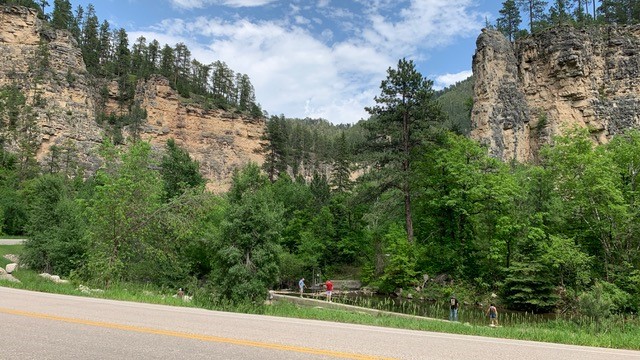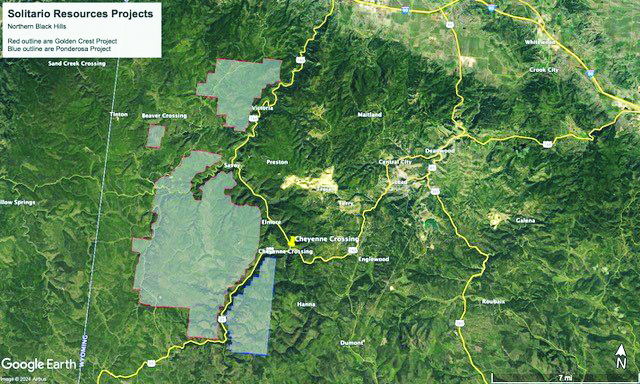No impact finding allows Forest Service to approve exploration drilling

Tourists at spillway in Spearfish Canyon. Left side of photo is the west rim of Spearfish Canyon, June 8, 2023/Photo by Carla R. Marshall
BLACK HILLS – Solitario Resources has been given the greenlight to go ahead with their proposed gold exploratory project in lieu of mining for gold near Spearfish Canyon, despite widespread opposition to it. The area is immediately west of Spearfish Canyon and stretches almost to the Wyoming border.
In a written statement published by ACCESSWIRE, Chris Herald, the President and CEO of Solitario said he was pleased their low-impact-drilling plan, known as the Golden Crest will result in no significant environmental impacts, as per the U.S. Forest Service’s release of their Decision Notice (DN) and their Finding of No Significant Impact (FONSI). The DNFONSI explains that an Environmental Impact Statement (EIS) isn’t necessary because the Forest Service Ranger District found no impact to the human environment.
The USFS said the project would be subject to National Environmental Policy Act (NEPA) provisions. They state that they prepared an Environmental Assessment (EA) to determine if the activities would be significant enough to require an EIS. “The Golden Crest Exploration Drilling EA identified key issues associated with the Plan of Operation (PO), considered and assessed reasonable alternatives, evaluated and disclosed potential environmental effects, proposed mitigation necessary to minimize adverse impacts, and ensure compliance with applicable laws, regulations and policy. Therefore, the USFS has fulfilled statutory requirements and agency policy and direction to comply with NEPA and other relevant authorities,” stated the USFS
The project site is in the Limestone Plateau and Big Hill areas or the northern Black Hills southwest of Spearfish and west of Lead. It’s in an already disturbed area, making it more suitable for drilling. The PO calls for 25 core drill platforms, and the DNFONSI estimates the footprint of each drill to be 25-feet by 75-feet, or 1,875-square feet where the drilling rig, rods, support vehicles, water truck and sump would be placed. Each drill pad could have up to 5 drill holes averaging 1,300 feet in depth but depths of 1,640 have been proposed. The number of drill holes on each drill pad would depend on the findings. Holes would be drilled vertically and angled.
About 5,000 to 10,000 gallons of water per day would be used per drill rig, with a maximum of 24,000 gallons per day. Water used for drilling would be mixed with industry-standard drilling additives. While no water source has yet been identified, the DNFONSI says that no water would be sourced from Spearfish Creek or other local surface water on National Forest Service (NFS) lands.
The USFS said this project is not like other drilling projects or similar well drilling activities, but projects like this are routinely approved and aren’t expected to be different or outside the effects of previous and similar projects.
No bonding amount is listed because the USFS process doesn’t require any calculations before the publication of the final EA. The financial assurance should consider all activities and mitigations required under the decision.
If an aquifer is penetrated, the completed drillholes would be plugged from bottom to top using bentonite grout. There is a plan in place for the plugging of boreholes after they are no longer in use.
The USFS has no authority to prohibit projects and can only regulate. The responsibility of the USFS is to identify and evaluate the potential impacts to natural resources and to develop mitigation measures. Their actions are overseen by the General Mining Law of 1872. The Law has undergone some changes over time, for instance allowing for the sale or public giveaway of certain minerals like sand and gravel and allowing for the development of multiple minerals on the same tract of public land.
Missing in the documents are avenues of accountability, in the event of a spill or contamination.
“Accountability is the real problem,” said Lilias Jarding from the Black Hills Clean Water Alliance. Jarding says the Law is antiquated. “It’s a bad law. The 1872 Mining Law was signed by President Grant. And back then it was pick and shovel mining. People have tried to amend it repeatedly, and in fact there’s a bill in Congress right now that would make it easier to mine under the 1872 Ming Law, if that’s possible. It completely voids any protection of the public’s lands. The Forest Service always throws their hands up in the air and say they can’t do anything to stop this because of the 1872 Mining Law. But there’s the Clean Water Act, the National Environmental Policy Act, the Clean Air Act, the Endangered Species Act – there are lots of acts that apply in these circumstances that are designed to protect the environment and resources and wildlife and people and everything else. But they just focus on one law.”
The DNFONSI says as per the National Forest Management Act, the Forest Service’s approval for Solitario “to explore for mineral resources” is consistent with the intent of the agency’s long-term goals and objectives. They also say they’re in compliance with NEPA. Although the USFS and Solitario have Clean Water Act requirements to meet, they say there will be no adverse impacts to water resources. There is a wetland near one of the platforms. But there will be no direct disturbances as mitigation measures include relocating the drill downgradient from the wetlands.
The Forest Service says there were no requests to engage in consultation by any of the Tribes even though several attempts to engage in dialogue were made.
The project is adhering to National Historic Preservation Act requirements. There is a previously documented historical site that is under an existing road. Jarding explained the mitigation requirements. “This archeological site is under where they are running heavy equipment. And they are covering it with 4-inches of gravel. It is covered to some extent now. But for the project they will have to put 4 inches of gravel over it to protect it.”
The” No Adverse Effect” finding was submitted to the South Dakota State Historic Preservation Office (SHPO) and the sixteen Tribal Historic Preservation Offices (THPO). The two concurrences with the finding were the Northern Cheyenne and Spirit Lake tribes
There were no other historical sites found and the Forest Service ensures that no historical sites will be impacted.
Despite being one of South Dakota’s major industries, there is no public dashboard available to compare the revenue collections to the costs of cleanup. The Center for American Progress says that the Outdoor Recreation Economy is a sustainable diverse economy compared to the boom-and-bust cycle of extractive industries. Nearly half of the population in the U.S. each year go hiking, biking, fishing, skiing, rafting, and biking. Fast facts from the South Dakota Tourism Industry found that in 2023 14.7 million visitors traveled to and around South Dakota and spent nearly $5 billion dollars, a nearly 5-percent increase from the previous year.
Jarding said it doesn’t make sense to mine in the Northern Black Hills in an area that is covered by treaties and provides recreation for thousands of people every year. “You think about how this water will run through Spearfish Canyon. There are hundreds of thousands of people who go through there just during the Rally. It makes no sense economically,” she continued. “The mining industry is less than 1 percent of employment in the Black Hills. It’s not like it’s a big employer. The Warf Mine is the only operating large scale mine in the Black Hills region and represents an infinitesimal amount of money compared to the amount that is brought in by agriculture, as separately as the amount brought in by tourism and outdoor recreation. Those are billion dollars plus industries. So, economically it doesn’t make sense to do more mining. The impacts are permanent. The little income that comes to the state as opposed to stockholders somewhere is a very small amount than what it takes to clean these projects up.”
The Gilt Edge Mine was abandoned in 1999. “The Gilt Edge is now up over $140 million dollars to just try to control the water that’s coming out of the area where they mined, that’s contaminated.,” said Jarding. “It will come out permanently because they hit groundwater. To stop the water from flowing they would have to expire the aquifer because the source is an underground aquifer. This is a problem that is common to gold mining in other places as well. There is nothing to stop these companies from going bankrupt. That’s what happened with the Gilt Edge Mine owner who went bankrupt and left. And let the taxpayers pay the price. That again is not unusual.”
Jarding said the mining industry is considered one of the most corrupt industries in the world. “It’s a powerful industry and to stop them from doing what they want to do in the Black Hills, people have to have powerful voices, they have to oppose mining with their voices, time, money, and with other people working with alliances. It’s not a simple project,” she explained. “It’s not a sprint, it’s a marathon. There’s still a lot that can be done to stop mining in the area where Golden Crest is exploring. So that’s something that people need to be mentally prepared for because there will be a lot more fighting if they decide to mine.
(Contact Marnie Cook at staffwriter@nativesunnews.today)
The post No impact finding allows Forest Service to approve exploration drilling first appeared on Native Sun News Today.

